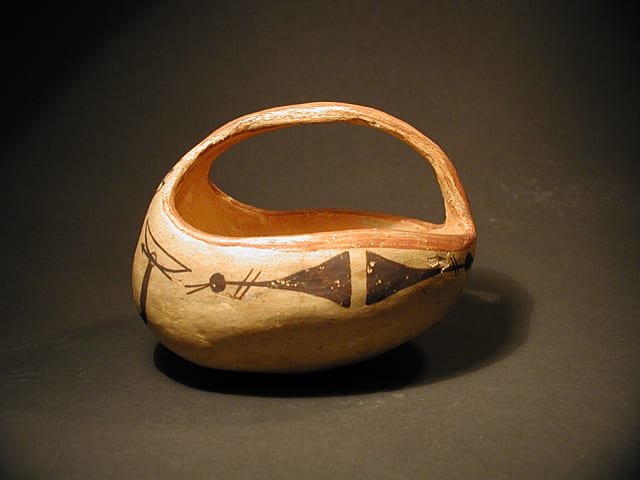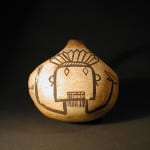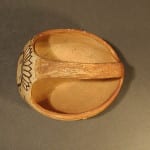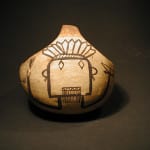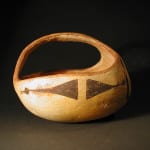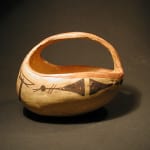Hopi Polacca D oblong bowl with handle crackled white finish, red rim, and handle. Dating from about 1890, this is probably a cornmeal pot used by villagers who circle around dancing kachinas in the public plaza of a Hopi/Hopi-Tewa village and bless the kachinas with the cornmeal. It may have been made for use or for sale at Keam’s trading post, or both. Keam encouraged the use of kachinas on Hopi pottery because they were attractive to Anglo tourists.
The public display of this pot is indicated by Suzanne Kenaghy’s dissertation research (1990), which concludes that pottery used in the most secret and sacred pueblo ceremonies was largely undecorated (like 1992-10 and 2005-17 and 2005-18). Pots with symbolic decorations (like the kachinas and designs on this pot) “were often used only in the public portions of rituals, to signal the presence of power to uninitiated people” (Hays 2000:51, summarizing Kenaghy in Schaafsma).
On the higher end of this pot is a monochromatic kachina with a feathered headdress and a beard. In one hand, he holds a bow and arrow, and in the other he holds a yucca whip. On each side are two triangular elements with abstract prayer feather designs. These design elements are not found in Wade & McChesney Historic Hopi Ceramics, though the Keam collection includes a Polacca C handled pot of round shape (1981:450,#P.M. 44-8-10/26617, Keam 1828). Based on the description offered by Barton Wright (1977: 32 and 36), the kachina depicted on this pot may be a Hu or Tungwup, a whipper kachina. Apparently, Hu/Tungwup particularly dances before the Bean Dance, which initiates children into the kachina cult. Whipping is part of the initiation. Alternatively (given the headdress), he might be Wuyak-kuita, (Broad-Faced Kachina)—although Wuyak-kuita is not depicted carrying a bow or arrow (Wright, 1977:39 & 42).
The side elements of this pot are interpreted by Fewkes (1973:89-90 and see Plates 78 and 83) as highly conventionalized birds with tail feathers, perhaps prayer offerings, nakwakwoci.
For a modern cornmeal pot, see 1998-14. For another handled ritual vessel made about 20 years later than 2004-03, see 1996-01.

